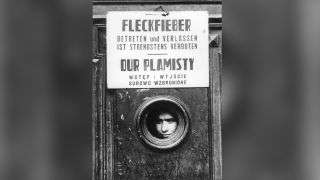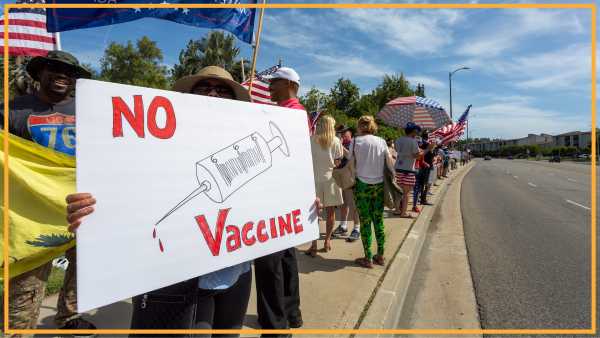
World War II, Warsaw ghetto during the German occupation. Homes where infectious diseases were detected, in this case typhus fever, were closed off from the surrounding area.
When a deadly typhus outbreak struck Poland’s Warsaw ghetto during WWII, Jewish doctors helped stop the disease in its tracks, saving thousands.
More than 400,000 Jewish people were crammed into the 1.3-square-mile (3.4 square kilometers) ghetto in the Nazi-occupied country, and severe overcrowding, exposure to the elements and starvation created a perfect incubator for epidemics. When typhus broke out in 1941, it should have devastated the ghetto’s vulnerable population.
But the disease began to sharply decline far sooner than expected, a new study finds. Swift containment efforts by the ghetto’s Jewish community succeeded in ending it sooner than if it had naturally run its course, sparing more than 100,000 people from infection and likely preventing tens of thousands of deaths.
Typhus is caused by the bacteria and is transmitted rapidly by infected fleas or body lice that travel from person to person, according to the Centers for Disease Control and Prevention (CDC). The disease causes high fever, chills, coughing and severe muscle pain, and it is fatal in about 40% of cases if untreated, the World Health Organization (WHO) says. “Explosive epidemics” of typhus are especially likely to surface when people live in overcrowded conditions with poor hygiene, according to WHO.
Such was certainly the case in the Warsaw ghetto. All Jewish residents in Warsaw and several thousand from Germany were forcibly relocated to the ghetto by November of 1940; authorities then sealed the ghetto off from the rest of the city, according to the United States Holocaust Memorial Museum (USHMM). In addition to the overcrowding, soap and water were scarce, and food rations were “not sufficient to sustain life” — an estimated 83,000 Jewish people died of starvation and disease between 1940 and 1942, the USHMM says. (The ghetto was ultimately “liquidated” by the Nazis in 1943, and the Jews who were not murdered there were sent to concentration camps.)
Records show that a typhus epidemic emerged in the ghetto in the beginning of 1941, but it began dissipating in late October of that year. By November, the appearance of new cases had dropped by about 40%, and the typhus outbreak subsided with only about 10% of the population affected, despite winter usually being prime season for typhus, researchers reported today (July 24) in the journal Science Advances.
At the time, the epidemic’s retreat was hailed by the ghetto’s inmates as miraculous, but diseases don’t just miraculously disappear. To see what really happened, the researchers used mathematical modeling to map the spread of typhus among the ghetto population, simulating the number of new cases that could be expected to appear in an outbreak with no community mitigation.
“Anti-epidemic activities”
The models showed that the epidemic should have continued to infect people during the fall and winter months, and would have sickened nearly every person in the ghetto, according to the study. Something stopped it — likely “anti-epidemic activities in the ghetto,” the researchers wrote.
“Fortunately, many of the anti-epidemic activities and interventions are well documented,” said lead study author Lewi Stone, a professor with the Faculty of Life Sciences at Tel Aviv University in Israel, and with the School of Science at Royal Melbourne Institute of Technology and Melbourne Technical College in Australia.
“It turns out that the Warsaw ghetto had many experienced doctors as inmates,” Stone said in a statement. “Some of them survived to write about their experiences and sketched the basics. To learn more, I spent many, many hours in libraries around the world seeking rare documents or publications to find details about the interventions employed.”
Related Content
– Going viral: 6 new findings about viruses
– 10 deadly diseases that hopped across species
– Top 10 mysterious diseases
Stone and his colleagues reported that Jewish doctors and community leaders enforced social distancing and quarantines for those infected — as much as was possible in the highly overcrowded ghetto — promoted awareness of the disease and hygiene through public lectures, and they even trained medical students in secret. Policy changes by the Nazis that allowed Jewish council members to bring more food and soap and water into the ghetto (in order to eke more work out of its inhabitants) may have also helped, the study authors found.
“In the end, it appears that the prolonged determined efforts of the ghetto doctors and anti-epidemic efforts of community workers paid off,” Stone said in a statement. “There is no other way we can find to explain the data.”
The defeat of this deadly disease even under appalling conditions and life-threatening circumstances was a remarkable achievement and one that is “directly relevant to the present COVID-19 crisis,” said study co-author Yael Artzy-Randrup, an assistant professor with the Institute for Biodiversity and Ecosystem Dynamics at the University of Amsterdam.
“The actions of individuals in practicing hygiene, social distancing and self-isolating when sick, can make a huge difference within the community to reduce the spread,” Artzy-Randrup said in the statement.
Sourse: www.livescience.com





